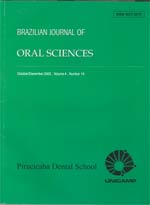
|
Brazilian Journal of Oral Sciences
Piracicaba Dental School - UNICAMP
EISSN:
Vol. 9, No. 2, 2010, pp. 120-123
|
 Bioline Code: os10026
Bioline Code: os10026
Full paper language: English
Document type: Research Article
Document available free of charge
|
|
|
Brazilian Journal of Oral Sciences, Vol. 9, No. 2, 2010, pp. 120-123
| en |
Effectiveness of intraoral suction systems and aspirating tips for evacuation of aluminum oxide particles during use of air-abrasion
Scannavino, Fábio Luiz Ferreira; dos Santos-Pinto, Lourdes & Hernandes, Antonio Carlos
Abstract
Aim: The purpose of this study was to compare the effectiveness of a high-volume evacuation and a conventional intraoral suction system and aspirating tips for capturing aluminum oxide particles during use of an air-abrasion device.
Methods: A phantom head was fixed at the dental chair head with secured a metallic device with 5 horizontal shafts, corresponding to operator′s clockrelated working positions, and one vertical shaft to simulate the operator′s nasal cavity. Petri plates were fixed to the shafts at distances of 20, 40 and 60 cm from the center of the oral cavity of the phantom head to collect the aluminum oxide particles spread over during air abrasion. The dust was aspirated with two types of suction tips used with both suction systems: a conventional saliva ejector and a saliva ejector customized by the adaptation of a 55-mm-diameter funnel.
Results: The amount of particles showed that the greatest abrasive particle deposition occurred at a distance of 20 cm from the center of the oral cavity of the phantom head at 9 o′clock operatory position with the conventional saliva ejector attached to high-volume evacuation system.
Conclusions: The greatest deposition of aluminum oxide particles occurred at the shortest distance between the operator and the center of the oral cavity, while using the high-volume evacuation system associated to the conventional suction tip.
Keywords
air abrasion, dental vacuum systems, aluminum oxide powder
|
| |
© Copyright 2010 Braz J Oral Sci.
Alternative site location: http://www.fop.unicamp.br/brjorals
|
|
